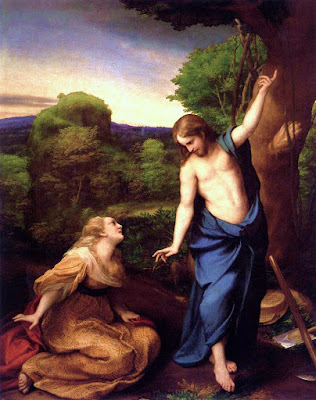Book II
The Redcrosse knight awaytes,
Findes Mordant and Amauia slaine
With pleasures poisoned baytes.

 |
| Jesus and Mary Magdalene (c. 1534) Antonio da Corregio source Wikimedia Commons |
 |
| The Three Marys at the Tomb of Christ (c.1603) Adam Elsheimer source Wikimedia Commons |
** paintings above are The Resurrection of Christ (1565) by Tintoretto & Resurrection of Christ (1875) by Carl Bloch, both on Wikiart. I had so much trouble with this post —- Blogger deleting whole posts, etc. that I’m terrified to touch anything else! Happy Easter everyone!
Thanks to Amanda, here’s the poem in song!
As you’re probably aware from both my On Reading the Faerie Queene and Spenser’s Images of Life posts, I’m gearing up to read The Faerie Queene in late April. But instead of sliding quietly into the read-along, I thought it might be nice to give it an official announcement!
O at Behold the Stars was the instigator of this event and Jean, Cirtnecce, Ruth, Consoled Reader and I quickly followed her lead. We will be attempting to stick to this schedule:
Thanks to O for the prod, and to Jean’s husband for creating a rather awesome button! Anyone else who would like to join us is very welcome! Reading this tome among friends will make it much less intimidating!
And, coincidentally corresponding with the above read, in April Hamlette from The Edge of the Precipice is going to be hosting a Poetry Month Celebration in honour of National Poetry Month.
We’ll be starting The Faerie Queene read-along near the end of the month, but I hope to be able to read a few more poems, at least one per week, for this event. It’s a good chance to focus on that category for my Deal Me In Challenge.
So if either of these events interest you, I hope you’ll join us for a very busy April, and ring in the spring with poetry!
Normally, I don’t read introductions or commentaries on books or poetry that I plan to read, until after I’ve finished the work. I prefer to experience the art from a point of innocence (or perhaps, ignorance is a better word!), forming my own opinions without influence, even if I struggle with my first read through. However, this time I threw all my ideals to the winds and called for help.
In April I’m reading The Faerie Queene with O, Cirtnecce, Jean, Ruth, and Consoled Reader, and considering the length and complexity of this poem, I confess that it was wiser to admit my complete ineptitude and look for someone who was very familiar with this type of poem and era to give me a little boost. Since C.S. Lewis’ expertise was in Medieval and Renaissance literature, I suspected that he would be a good place to start. His book, Spenser’s Images of Life is a compilation of lectures notes, put together by Alastair Fowler, to give students a deeper insight into The Faerie Queene.